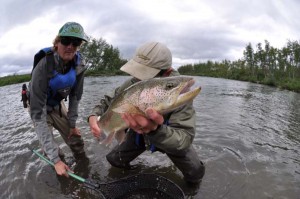Your fly fishing jacket is more important than beer or duct tape. Welcome to gear talk about jackets worn in the Bristol Bay, Alaska. You can cut corners to save money to make your fly fishing trip affordable, but there are three places you don’t scrimp. 1. Do not hire an inexperienced floatplane pilot. 2. Don’t bring worn out waders. And, 3. . . . don’t bring a cruddy jacket!
We depend more on good jackets for our angling success, comfort, and potentially our survival than all the other gear we pack along. Our waterproof jacket combined with breathable waders is more critical than our choice of fly rods or fly selection – more important than which river we select. Our jacket is more important than whether we chose a lodge, a do it yourself trip, or a guided float trip. Our outer layer is our new best friend.
Gore-Tex or equivalent waterproof-breathable jackets define Bristol Bay comfort and safety. Your jacket must absolutely repel wind driven rain, withstand some abrasion, be wind proof, be durable, not leak, and the cuffs and hood must be adjustable. You can use commercial fishermen’s rain jackets to accomplish this with some loss of comfort.
I get asked, “Can Gore-Tex be depended on?” The better manufacturers of waterproof outerwear finally achieved in the 1990’s the promise of “Light & Dry & Breathable” that they began promoting in the 70’s, and failed under field conditions until the 90’s. Yes, Gore-Tex and a few other waterproof-breathable brands (H2NO, eVent) work incredibly well! Bristol Bay guides wear these materials week after week.
Bring the best hooded jacket that you can afford, preferably built of 3-layer fabric. If you are willing to fork out the cash, then consider the Gore Tex or H2NO guide jackets by Simms and Patagonia. They are incredibly well designed to keep you comfortable while casting and have details that restrict rainwater from running into your sleeves. I have personally had positive experiences with the following jackets of 3-layer waterproof-breathables: Simms, Patagonia, Orvis, L.L. Bean, Cabelas, Arcteryx, Cloudveil, Moonstone, Marmot, Mtn Hardwear, & Northface.
These 3 layer Gore-Tex jackets are not cheap but you can expect to wear one for 5 years for rain/wind. And, those jackets marketed as “Mountain Hard Shells” double for winter sports like snowboarding, skiing, snowmobiling, etc. I currently wear Patagonia River Salt, Patagonia SST, or the Simms G-4 jackets. They are well designed for fishing in variable weather. The 1 or 2 layer waterproof back packing jackets designed primarily for light-weight and packability do not hold up well in Alaskan field conditions.
Economically there is an argument to be made re: 100% waterproof “commercial duty” rainwear vs. Gore-Tex. A 100% waterproof “commercial fisherman style” rainwear “slicker” by Helly Hansen, Grunden, or similar is highly serviceable costing less than $150 compared to $250+ for Gore Tex. Many Alaskans have proudly worn “Helly Hansen Rainwear” for years and snickered at the fancy Gore-Tex. Try to get a model with adjustable cuffs to keep water from running up your sleeve and a drawstring hood. Whatever you choose – It must absolutely keep you dry! Shop carefully.
If you are bringing a Gore Tex jacket that you’ve worn previously, no matter whether it kept you perfectly dry make sure to re-vitalize its repellency just prior to the trip. The fabric needs to be re treated with DWR (Durable Water Repellant) finish. It makes a huge difference to how efficiently your jacket performs. You are going to be fishing close to the Bering Sea. Think about it. Use ReviveX to restore and enhance repellency. http://www.mcnett.com/ReviveX-Spray-On-Water-Repellent-P316.aspx. See you out there with a smile in rain or shine.


